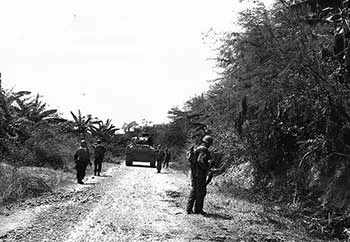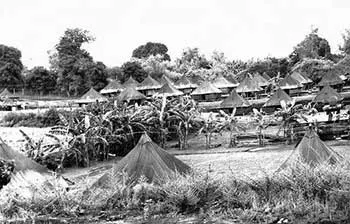Stories about the Liberation of Batangas City from Japanese Occupation
[Topics in this article: Batangas City Batangas, World War II in Batangas, Liberation of Batangas, Nasugbu landing 1945, PT boats Batangas, US Army Sub-base R, Batangas airfield, Lipa airstrip]
From the so-called “historical data” of Batangas City1 – documents required by the national government in 1951 of Department of Education districts around the country to reconstruct local histories because of destruction caused by World War II – we get these otherwise forgotten stories set in the then-town of Batangas at around the time of the liberation of the province from Japanese occupation.
As has been stated in other articles with content based on these so-called historical data, the information culled from these documents cannot be taken at face value. Often, the documents contain transcriptions of people’s memories and often wanted for more details. Sometimes, the information is also difficult to corroborate with credible sources.
 |
| The 158th Regimental Combat Team advancing towards Batangas town. Image source: United States National Archives. |
“On November 25, 1944, a squadron of U.S. Army fighter planes made their first appearance in the skies of Batangas. The people were alarmed by the strange airplane sounds at about 10:00 a.m. Then followed the explosion of bombs faintly heard by the townsfolk.
The Lipa airstrip was being pounded. After ten minutes’ pounding of the airport, the sound became more audible and finally deafening. The planes soared above the skies of Batangas and circled around. Before they could finish the circle, they banked and dived one after another raining death and destruction on the Batangas Airport.
The Japanese anti-aircraft (guns) barked and retaliated but all the planes left unscathed. The planes reappeared the following week and came in regularly thereafter until the airstrip was totally destroyed.”
 |
| Photo of the Batangas airdrome under attack by American planes in 1945. Image source: United States National Archives. |
“In December of the same year, the town (Batangas) was hammered by P.T. gunboats4. The civilians fled in panic, but were very happy (about the PT boat attacks, presumably on Japanese ships) for it was a sure sign that the liberators (i.e. the US Army) will very soon arrive. About the middle part of January, 1945, clouds of bombers and fighters appeared in the skies south of Batangas. They were escorting U.S. transport ships loaded with U.S. soldiers which made their successful landing in Nasugbu, Batangas.”
“On March 8 and 9, 1945, the Japanese applied the scorched earth measure to this town (Batangas) knowing pretty well that the American soldiers would be due any minute. In the evening of March 10, 1945, the Americans who were at Bolbok, Batangas incessantly shelled the town until the following day. They entered the town in the morning of March 11 but the Japanese offered only a very slight resistance.”
“Soldiers’ camps sprung (up) like mushrooms; ships docked in Batangas Bay (i.e. the pier); tools, equipment, food supplies and clothing were unloaded and brought to the depot. Batangas finally became a base called Sub-Base ‘R.’ Schools were opened in June 1946, financed by the PECAU for 3 months. Slowly and gradually, the normal life was restored with the reconstruction and rehabilitation of buildings that were remnants of the war.”
Indeed, Batangas was quickly transformed into one of the US Army’s so-called “letter bases,” which were “major area commands” and logistics centers. As Sub-base R, Batangas was under the umbrella of Base M in San Fernando, Pampanga10. Numerous pictures taken by the US Army’s Signal Corps are filed away at the United States National Archives. Unfortunately, Batangas History is unable to find any Internet documents about PECAU other than a vague reference to it having been part of the US Army. The acronym probably stood for an organization within the army that took charge of reconstruction and rehabilitation after the war.
The following two articles provide pictures and information about Base R in Batangas in 1945 and the immediate post-war years:
“RELATED ARTICLES:
More about Base R, an American Logistics Base in Batangas City in WWII”
“US Army Signal Corps Pictures while in Batangas City Post-World War II”
2 “US Army in World War II, The War in the Pacific, Triumph in the Philippines” by Robert Ross Smith, published in 1993 by the Office of the Chief of Military History, Department of the Army, Washington D.C.
3 The Philippine Army Air Corps was the forerunner of the Philippine Air Force. “Philippine Army Air Corps,” Wikipedia.
4 PT Boats were motorized torpedo boats of the United States Navy in World War II. “Wikipedia.”
5 “Explosive Motorboats based in the Philippines 1944-1945,” by Bob Hackett and Sander Kingsepp, online at CombinedFleet.com.
6 “Suicide Squads: The Men and Machines of World War II Special Operations,” by Richard O’Neill, published 1981.
7 “The Angels: A History of the 11th Airborne Division 1943-1946",” by Major Edward M. Flanagan Jr., published 1948 in Washington.
8 “Scorched earth,” Wikipedia.
9 “List of Towns Liberated by the US Army from 17 October 1944 to 11 August 1945,” created 1945 by the Office of the AC/S for Intelligence, G2, United States Army Philippines-Ryukyus Command.
10 “US Army Letter Bases,” online at Pacific Wrecks.


